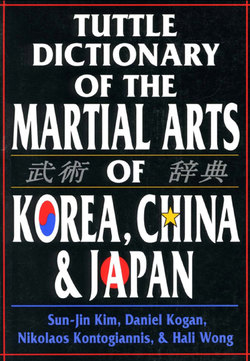Читать книгу Tuttle Dictionary Martial Arts Korea, China & Japan - Daniel Kogan - Страница 8
На сайте Литреса книга снята с продажи.
ОглавлениеPronunciation Guide to Korean
Two major transliteration systems are used in Korea: the Ministry of Education system and the McCune-Reischauer system. Because of its frequent use of apostrophes to indicate aspirated consonants and accent marks to change vowel sounds, the Mc-Cune-Reischauer system has been avoided here. Instead, we have used the Ministry of Education system, which represents the various sounds of the Korean language as follows:
a as in the "a" in father
ae as in the "a" in fat
b as in boy
ch as in child
d as in door
e as in the "e" in pet
eo as in the "u" in but
eu as in the "oo" in foot
g as in golf
h as in hello
i as in the "ee" in feet
j as in jar
k as in key
l as in light
m as in moon
n as in not
o as in the "o" in go
oi as in the "way" in way
p as in pen
r as in the "r" in red when used to start a word, but rolled as a Spanish "r" when preceded by a vowel within a word
s as in say
t as in toy
u as in the "oo" in soon
w as in was
y as in yellow
You will no doubt notice double consonants such as "bb" in some Korean words. Such pairs receive more aspiration than the corresponding single consonants. For example, b sounds like the ordinary "b" in boy, and p sounds like the "p" in pen, but "bb" falls in between—much like the p in the normal pronunciation of the word "open." Even if you have trouble differentiating single and double consonants, keep in mind that most Koreans will be able to understand you no matter how imprecisely you enunciate. The language's absence of tones—such as those in Chinese—further facilitates pronunciation and understanding.
Please note that the "si" combination is usually pronounced as "she"; therefore, "sip" (the number 10) sounds like "sheep" and not "sip" or "ship." When the letters "ssi" are used together, however, they are pronounced "see" with emphasis on the "s" sound. Thus, Ssi Rum is pronounced "see reum" and not "shee reum."
You will also notice that several letters and sounds—f, v, th, z, etc.—are conspicuously absent. This is because they do not exist in Korean.
Note on the labels used within each entry:
The first label indicates which language the term is from. Therefore all terms marked (C) are from Cantonese, (J) are Japanese, (K) are Korean, (M) are Mandarin, and (O) are from the Okinawan dialect. The second label is the category of the word. It indicates what general subject the word concerns, be it a specific style, a religion, a type or part of a weapon, etc. The "common usage" category is for words that are used in a wide variety of categories or are not specific to the martial arts.
Although most non-English terms have been italized when they appear in the text, when entries are cross-referenced, they have been written in roman letters.
